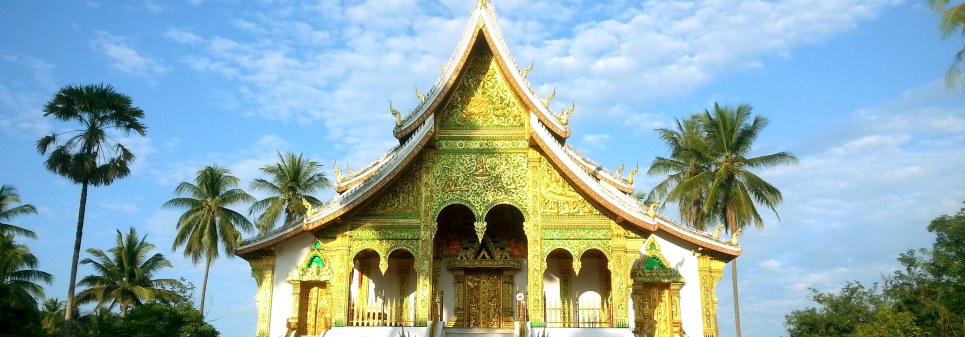Set at the confluence of two rivers that almost surround the town, and beneath a temple-topped hill, Luang Prabang was the ancient royal capital of the Lan Xang Kingdom until 1545. After being recognized as UNESCO’s site since 1995, Luang Prabang has been arise as an famous destination with its amalgamation of crumbling French architecture, glistening temples and extensive natural beauty. The town’s entire historical section is dedicated to tourism, with everything from former royal palaces to over 33 Wats (temples), on the tourist trail. This former Royal capital still remains the main centre for Buddhist learning in Laos and is the perfect location for spiritual contemplation.

Location
Luang Prabang located in north central Laos, at the confluence of the Nam Khan river and Mekong River about 425 km north of Vientiane
Quick facts
Population: 408.800
Area: 16.875 km²
Dial code: +856 – 71
History
Luang Prabang rose to prominence as the capital of the first Lao kingdom (Lan Xang – land of the million elephants) from 1353 onwards. The fragmentation of the Lao kingdom at the end of the 16th century saw Luang Prabang become a militarily weak independent city state paying tribute to the surrounding kingdoms. Ultimately the 1887 sacking of the city by the Chinese Haw led the Luang Prabang monarchy to accept the protection of the French, whose influence led to the construction of the many fine colonial villas that sit harmoniously alongside the traditional Lao architecture.
The city fell into decline in the latter half of the 20th century following the reluctant withdrawal of the French, and the 1975 revolution which brought an end to the Luang Prabang monarchy. The relative poverty of newly-independent Laos perhaps helped save Luang Prabang from the ravages of 20th century city planning.
Climate
Luang Prabang features a tropical wet and dry climate under the Köppen climate classification. While the city is generally very warm throughout the year, it is noticeably cooler during December and January. Luang Prabang also experiences wet and dry seasons, with the wet season from March until September, and the dry season during the remaining five months.
Best time to go
Best time to visit Luang Prabang is between October and April.
Banks
Indochina Bank operates foreign exchange counters on the main road of King Sisathat Road. http://www.indochinabank.com/
Join Development Bank (JDB), locates next to Indochina Bank on King Sisathat Road. http://www.jdbbank.com/
BCEL operates foreign exchange counters on the main road near Wat Visoun. http://www.bcel.com.la/la
Hospitals: Luang Prabang Provincial Hospital; Tel: + 856 71 254 023
Arlines
The airport is just north of town and has scheduled flights from/to Bangkok, Chiang Mai, Hanoi, Jinghong, Pakse, Siem Reap, and Vientiane.
Bangkok Airways offer flights from/to Bangkok.
Laos Airlines offers flights from/to Bangkok, Chiang Mai, Hanoi, Jinghong, Pakse and Vientiane.
Lao Central Airlines flies daily from Vientiane
THAI (Thai Airways International Public Company Limited) has weekly flight from Bangkok to Luang Prabang since October 2014
Vietnam Airlines offers flights from/to Hanoi and Siem Reap. Vietnam Airlines’ pricing scheme is somewhat questionable, with tourists paying higher prices on last-minute tickets.
Top highlights in Luang Prabang
- Highlight Activities
- Main sight-seeings in Luang Prabang
- Local cuisine
Read more here : Highlights in Luang Prabang








